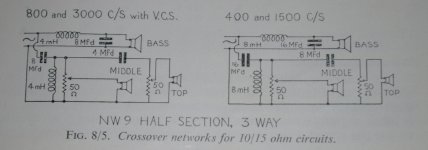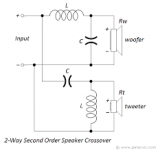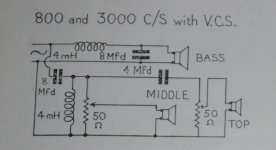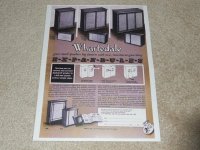You may want to get an LCR meter and measure the value of each component of the original crossover, that way you can pretty much reproduce it with new components (while you're at it measure the new values too). Older components had tolerances of +/- 10 or 20% (unless they happened to have been selected or matched between speaker pairs) and in addition those values may have changed over time, so two "identical" speakers could sound slightly different, not even counting variations in drivers.
https://www.testequipmentdepot.com/...BWhkWindVz1GnMg8w--hwNyQz0huEFkRoCWUQQAvD_BwE
See if this link will open. I have an inexpensive DMM with LCR. I have had Meniscus Audio wind me several different values of custom coils. This meter of mine is not as accurate as what they probably use but it is close enough for what I need. It only measures inductance and capacitance at 100 Hz as far as I can tell; I would like it better is could also do that at 1 KHz and at 10 KHz. This meter has a suggested retail just under $65 US. Great DMM for that price! In case the link does not open; just do a search for "PROS KIT MT-5211" or "ECLIPSE MT-5211".
Hi Topping , I looked up B&W 802 Diamond - 360,000 results, could you narrow it down a little Please?????? -- like a a link to click on -- or an specific page to look up ??????
--- 1. Question - What I don't understand is why that crossover would work for the Wharfedale 8 inch Midrange, don't crossovers have to be specific to a driver ?? and Also what other drivers are in that crossover , and doesn't each crossover have to match the frequencys that the other drivers are crossing over at???
- Hi topping , this is very confusing you never did answer my # 1. Question above --
I dont have the schematic for the crossover that was installed in a w70 that i had 12years ago, even if i did that is not how id construct one now.
Note how the tweeter circuit is taken off the midrange filter circuit, and not taken directly off the input.
- Hi Galu , Yes that is helpful! - It's also intresting to see what the designers there at wharfedale were thinking. Do you know what year this was? --- or which speaker they used them in ?
- Each of the xovers has an extra cap and an extra coil compared to mine - so maybe they are just a few years further along from mine . . .
- as Wharfedale learned or understood more then of coarse they implimented those ideas in the newer versions. It's easy to forget they didn't have many of the tools we use today to measure and design with.
--- My W70's had a 4 mfd/uF , and an 18 mfd/uF , a single coil and of coarse the two 50 ohm L-Pads , I will try to draw mine out later today just like they did it here. They are Strange looking xovers..... at least to me - 😀
- the L-Pads that are mostly available today are 8 ohm , but all the guys who have used them in their w60's , W70's , and W90's say they can't tell the diference other than being new L-Pads .... they do sound better . -- I have found a couple of 50 ohm that are custom made, but they are $40 - $50 each so too rich for my blood , I need 4 of them - LOL
- Each of the xovers has an extra cap and an extra coil compared to mine - so maybe they are just a few years further along from mine . . .
- as Wharfedale learned or understood more then of coarse they implimented those ideas in the newer versions. It's easy to forget they didn't have many of the tools we use today to measure and design with.
--- My W70's had a 4 mfd/uF , and an 18 mfd/uF , a single coil and of coarse the two 50 ohm L-Pads , I will try to draw mine out later today just like they did it here. They are Strange looking xovers..... at least to me - 😀
- the L-Pads that are mostly available today are 8 ohm , but all the guys who have used them in their w60's , W70's , and W90's say they can't tell the diference other than being new L-Pads .... they do sound better . -- I have found a couple of 50 ohm that are custom made, but they are $40 - $50 each so too rich for my blood , I need 4 of them - LOL
These are generic crossovers and the images are taken from G.A. Briggs' book 'More About Loudspeakers', first published in 1963.Do you know what year this was? --- or which speaker they used them in ?
- the L-Pads that are mostly available today are 8 ohm
However, the same basic circuit appeared in the 5th edition of his earlier book entitled 'Loudspeakers' which was published in 1958.
16Ω L-Pads are available in the UK: 16 Ohm L-Pad Attenuator - 50 Watts - Willys-Hifi Ltd
At their heart they are just 2-Way Second Order crossovers as per the attachment.They are Strange looking xovers..... at least to me - 😀
The Wharfedale mid driver occupies the tweeter position of the attached diagram, while the Wharfedale tweeter is simply connected in parallel with the mid driver's inductor via a 4μF capacitor.
Attachments
- Thanks, that drawing makes a little more sense ........ so just talking out loud the tweeter is just seeing the cap and the inductor right, same as the midrange is... but the mid driver has the parts in opposite places than the tweeter. so is one a high pass and one a low pass?
- Someone that has a little experience with Wharfedale speakers said that they think that the drivers in my speaker would work better with a First order crossover ..... so time to do some looking around ..... , I wonder how I determine what would be good frequency's to use....
- Someone that has a little experience with Wharfedale speakers said that they think that the drivers in my speaker would work better with a First order crossover ..... so time to do some looking around ..... , I wonder how I determine what would be good frequency's to use....
The original crossovers in your W70s were 1st Order (6dB/octave)! If you want them to remain 1st order, then all you have to do is upgrade the 4μF and 18μF capacitors that were originally on your drivers! The single coil you mentioned should not require to be upgraded.Someone that has a little experience with Wharfedale speakers said that they think that the drivers in my speaker would work better with a First order crossover
It would appear that you need to bone up on crossovers, Dean! 😉
The generic crossover I attached is 2nd Order (12dB/octave) so permits less overlap between the drivers. The original 1st Order (6dB/octave) crossover allows greater overlap between the drivers.
The choice of a 1st Order crossover in the W70 was made either to save money (fewer components) or to 'splash' the sound around more!
The generic crossover is low pass on the woofer and high pass on the mid. The tweeter operates off the high pass section, but is further filtered by the 4μF capacitor.so is one a high pass and one a low pass?
We base that on your original crossover. Are the drivers all 15Ω impedance?I wonder how I determine what would be good frequency's to use
It does most of the time in right places. I ending up using foil or litz wound inductors in tweeter and higher crossed mid circuits most of the time.Thank you , does it make a difference if it is a " perfect Lay" inductor, or a foil inductor?
Assuming 15Ω impedance, I've calculated that the generic 2nd order crossover shown in the attachment would be a direct replacement for the original 1st order crossover of the W70.Are the drivers all 15Ω impedance?
These are the two options I suggest you consider:
- Simply upgrade the capacitors in the original 1st order crossover.
- Upgrade to the 2nd order crossover shown the attachment.
P.S. The original coils on your W70s should be 4mH. So, if you proceed with option 2, you already have two coils to start with and would only need to buy two more having the same type of construction as the originals.
Attachments
It does most of the time in right places. I ending up using foil or litz wound inductors in tweeter and higher crossed mid circuits most of the time.
I also prefer the flat foil or Hepa-Litz in my mids and tweeters X/O's Just like better capacitors; there IS a difference. Some people argue against this but if you do a direct comparison; sometimes the sound quality is very obviously improved with a higher quality inductor or capacitor; even resistors can affect the perceived sound "quality". There is, of course, a point where increasing the price gives you diminishing returns. I have my favorites because I have spent a lot of time doing direct comparisons. BUT, just because you spend more money does NOT ensure better results. There are a few reasonably price crossover components that perform much better than others in their same given price range. PM me if you want some of my "preferred" brands and series types.
Did you ever come across Wharfedale 'Expandules' (expandable speaker modules), oldspkrguy?
Not something that was introduced in the UK or I would have known about them!
I could have seen them in the past and not known about it. I went to the Consumer Electronics Show in Chicago one year when I was in high school. That's when "QUAD" was the big thing! I saw a LOT of speakers and systems in 2 full days! This would have been early to mid 1970's sometime; most likely 1972, 73 or 74. I was lucky enough to work for an electronics company repairing stereo equipment and CB radio equipment. It was a small business so the boss could do lots of things like take us to shows. Not many people at the CES in high school age group that's for sure! The boss had a pair of AR3a's and an entire AR stereo equipment set up. One of my Uncles had a Klipschorn (single/mono); my Dad did his own speakers, even one of my Grandfathers did HiFi (also back BEFORE stereo). I had a "record player" in my room as a toddler; it had the famous His Master's Voice gramophone and dog emblem as part of the speaker grill. So; old speaker guy goes ALL the way back to my very beginnings so to say!
Back to answer your question; that's a possible maybe...ha ha ha...can't say for sure though...
It would be nice to have a fully functioning system from the days gone by in good working order. I would definitely "cheat" and upgrade at least all of the X/O caps and resistors; maybe even the inductors if it were mine.
cheers!
Oh oops, no not these Hepa things from Solen. Technically it is a type 1 litz but IMO selection of the individual wire gauge defeated the purpose . Bough it first time around 20 years for simple 2 way and many designs later still won't use them anywhere in finished speakers just don't like the sound, but it still used s tuning coils while tinkering with crossovers. I winding my own litz coils using litz with individual wires gauge in range of awg 40-48 constructed like 5X3/27/46 or 5X5X44/40 equivalent awg 18-10. Nowadays less than before as foil coils became more available.I also prefer the flat foil or Hepa-Litz in my mids and tweeters X/O's Just like better capacitors; there IS a difference. Some people argue against this but if you do a direct comparison; sometimes the sound quality is very obviously improved with a higher quality inductor or capacitor; even resistors can affect the perceived sound "quality". There is, of course, a point where increasing the price gives you diminishing returns. I have my favorites because I have spent a lot of time doing direct comparisons. BUT, just because you spend more money does NOT ensure better results. There are a few reasonably price crossover components that perform much better than others in their same given price range. PM me if you want some of my "preferred" brands and series types.
People like to argue 🙂 but I use better sounding components when I can hear it despite the arguments. Price wise there is a certain limits. IMO no point to use cross components more expensive than a driver you trying to cross. Usually more expensive driver with moderately priced cross components yielding better results
Amen to that 🙂 Why don't you list your preferred brands here, it could be useful for other members tooBUT, just because you spend more money does NOT ensure better results. There are a few reasonably price crossover components that perform much better than others in their same given price range. PM me if you want some of my "preferred" brands and series types.
Last edited:
- Home
- Loudspeakers
- Multi-Way
- Crossovers and which Inductor is right?



